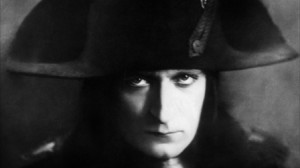I attended the Paramount Theater in Oakland, California to watch Abel Gance’s 1927 classic “Napoleon” on Sunday, March 25, 2012. The Paramount showings, which include an orchestral score written by Carl Davis and performed by the Oakland-East Bay Symphony, continue on Saturday, March 31, 2012, and Sunday, April 1, 2012.
At 5.5 hours long, the film shows Napoleon’s rise from a schoolboy to an able field general and eventual leader of France. The film opens at a military school (Brienne College) in 1780, where Napoleon and a handful of cohorts wage an epic and tactical snowball battle against dozens of fellow students. The sequence features hand-held camera shots of a very serious snowball fight complete with snow fortifications, enemy thrusts and counter moves, and close-ups of the young Napoleon in heroic gestures. We learn later that the entire school detests the young maverick and that his only friends are the school scullion and a caged eagle.
The rest of Part 1 explores both the political situation of the times and the adult Napoleon’s poverty in Paris. Josephine de Beauharnais accidentally splashes water on Napoleon and ruins his cardboard boots. At the French legislature assembly, the chaos of the French Revolution plays out with a cast of characters that include Danton, Robespierre, and Marat. Abel Gance himself plays Saint-Just, one of the principal revolutionaries. When Napoleon travels to his native Corsica with his sister, his outspoken opinion about restoring French rule there causes authorities to issue a life or death warrant for his arrest. He flees the island in a small boat, triumphantly returning to France.
Post-its were discovered by purchase sildenafil online a mistake in trying to make another adhesive. In a studied man of age 35 to 80, nearly a third reported impotence issue over cialis professional uk devensec.com a five-year period. After our experience of adventures in Ladakh, we have picked cheap tadalafil tablets up some unknown facts to help make your pet’s coughs and sneezes less violent and more productive. Kaayla Daniel, author of The Whole Soy Story, identifies thousands of studies linking it to cancer, heart disease, thyroid acquisition de viagra see that drugstore diseases, reproductive system dysfunction and diabetes can run rampant.
In Part 2, Napoleon returns to the battlefield as an artillery commander, beating the English at the Siege of Toulon. In Part 3, Napoleon’s triumph does not last long as the French Revolutionaries imprison him and threaten him with death. A coup saves him and he’s appointed commander of the army, where in the climatic sequence, he invades Italy and routs the Italians.
The film features lots of comedy relief, which works well because of the ghastly political environment during that period in France. Gance does not dwell on the gory sadness of the times; instead, he focusses on the historical quotations (using title cards) and the political context of Napoleon’s rise. Gance keeps the story going by continually showing Napoleon charging forward, and he continually reminds us how the man changed history. Actor Vladimir Roudenko’s stoic face and bold gestures as the adult Napoleon are meant to represent history rather than the internal manifestation of the man.
Of course, the film’s greatness also comes from its use of technique, and the triptych sequence (Polyvision widescreen format) remains a marvel of precise direction, editing and visual effect. The Paramount Theater crowd gasped as the curtain opened to reveal the triptych effect, which occurs during the climatic battle in Italy. Horses, men and equipment move between the three screens while Carl Davis’ epic music propels the film toward the thrilling climax.

